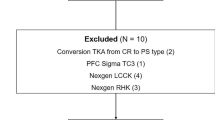Abstract
Early mechanical dysfunction of a total knee arthroplasty (TKA) is a challenging problem in terms of causality and solutions. The current strategy in our department is to perform a complete TKA revision rather than the less invasive partial procedures when a clear mechanical cause of failure has been found. In this investigation, we assessed 21 patients who underwent complete TKA revision in 2003–2004 in our institution within the first two years following the index TKA. Various clinical presentations included pain, stiffness, instability, and femoro-patellar signs. These corresponded to implant size, position, and fixation issues. The IKS knee score/function significantly increased from 47/47 to 85/78 at follow-up (six months minimum). Compared to the data in the literature, this systematic full revision seems to be a reasonable approach. This attitude takes advantage of the modularity of the implants for allowing perioperative adjustments of position, fixation, and constraint. Based on the results of our study, we propose a list of six mechanical pitfalls to be evaluated in the case of early dysfunction: frontal misalignment, sagittal overstuffing or malpositioning, axial malrotation, poor bone fixation, inappropriate constraint or ligamentous balance, and inappropriate level of the joint space.
Résumé
L’échec mécanique précoce d’une prothèse totale du genou (PTG) pose des problèmes difficiles en termes d’analyse des causes et des solutions chirurgicales possibles, notamment par réintervention partielle. Notre stratégie actuelle est de réaliser un changement complet de la prothèse (RPTG) lorsqu'au moins une cause mécanique a été mise en évidence, de façon claire. Dans cette étude 21 cas de RPTG précoce ont été analysés. Sur le plan clinique ces patients présentaient tous des douleurs associées de raldeur, instabilité ou de signes fémoro-patellaires. Ceux-ci correspondaient toujours à un défaut technique initial. Les scores IKS genou et fonction ne sont améliorés de façon importante après la révision compléte, passant de 47/47 à 85/78 à six mois minimum d'évolution. La comparison de nos résultats avec les données de la littérature sur les révisions partielles a montré que notre attitude radicale était raisonnable. Après cette étude, nous proposons 6 pièges mécaniques qui doivent ètre recherchés lorsque l'on se trouve confronté à un dysfonctionnement précoce de PTG: le un mal positionnement des implants dans le plan frontal, un mal positionnement ou un excés d'encombrement dans le plan sagittal, une mal rotation axiale des pièces, un défaut de fixation pour les prothèses scellées, l'utilisation d'un degré de contrainte inapproprié, enfin, un trouble lié a la hauteur de l'interligne articulaire (rotule).

Similar content being viewed by others
References
Babis GC, Trousdale RT, Pagnano MW, Morrey BF (2001) Poor outcomes of isolated tibial insert exchange and arthrolysis for the management of stiffness following total knee arthroplasty. J Bone Joint Surg Am 83-A:1534–1536
Cooney WP, Sierra RJ, Trousdale RT, Pagnano MW (2005) Revision total knees done for extensor problems frequently require reoperation. Clin Orthop Relat Res 440:117–121
Fehring TK, Odum S, Griffin WL, Mason JB, Nadaud M (2001) Early failures in total knee arthroplasty. Clin Orthop Relat Res 392:315–318
Fehring TK, Odum S, Griffin WL, Mason JB (2005) Outcome comparison of partial and full component revision TKA. Clin Orthop Relat Res 440:131–134
Gioe TJ, Killeen KK, Grimm K, Mehle S, Scheltema K (2004) Why are total knee replacements revised?: analysis of early revision in a community knee implant registry. Clin Orthop Relat Res 428:100–106
Haas SB, Insall JN, Montgomery W 3rd, Windsor RE (1995) Revision total knee arthroplasty with use of modular components with stems inserted without cement. J Bone Joint Surg Am 77:1700–1707
Kelly MA (2001) Patellofemoral complications following total knee arthroplasty. Instr Course Lect 50:403–407
Khaw FM, Kirk LM, Gregg PJ (2001) Survival analysis of cemented Press-Fit Condylar total knee arthroplasty. J Arthroplasty 16:161–167
Leopold SS, Silverton CD, Barden RM, Rosenberg AG (2003) Isolated revision of the patellar component in total knee arthroplasty. J Bone Joint Surg Am 85-A:41–47
Li PL, Zamora J, Bentley G (1999) The results at ten years of the Insall-Burstein II total knee replacement. Clinical, radiological and survivorship studies. J Bone Joint Surg Br 81:647–653
Lo CS, Wang SJ, Wu SS (2003) Knee stiffness on extension caused by an oversized femoral component after total knee arthroplasty: a report of two cases and a review of the literature. J Arthroplasty 18:804–808
Mackay DC, Siddique MS (2003) The results of revision knee arthroplasty with and without retention of secure cemented femoral components. J Bone Joint Surg Br 85:517–520
Nelson CL, Lonner JH, Rand JA, Lotke PA (2003) Strategies of stem fixation and the role of supplemental bone graft in revision total knee arthroplasty. J Bone Joint Surg Am 85-A[Suppl 1]:S52–S57
Peters CL, Hennessey R, Barden RM, Galante JO, Rosenberg AG (1997) Revision total knee arthroplasty with a cemented posterior-stabilized or constrained condylar prosthesis: a minimum 3-year and average 5-year follow-up study. J Arthroplasty 12:896–903
Sharkey PF, Hozack WJ, Rothman RH, Shastri S, Jacoby SM (2002) Insall Award paper. Why are total knee arthroplasties failing today? Clin Orthop Relat Res 404:7–13
Watanabe H, Akizuki S, Takizawa T (2004) Survival analysis of a cementless, cruciate-retaining total knee arthroplasty. Clinical and radiographic assessment 10 to 13 years after surgery. J Bone Joint Surg Br 86:824–829
Wright RJ, Sledge CB, Poss R, Ewald FC, Walsh ME, Lingard EA (2004) Patient-reported outcome and survivorship after Kinemax total knee arthroplasty. J Bone Joint Surg Am 86-A:2464–2470
Author information
Authors and Affiliations
Corresponding author
Rights and permissions
About this article
Cite this article
Rousseau, MA., Lazennec, JY. & Catonné, Y. Early mechanical failure in total knee arthroplasty. International Orthopaedics (SICO 32, 53–56 (2008). https://doi.org/10.1007/s00264-006-0276-7
Received:
Accepted:
Published:
Issue Date:
DOI: https://doi.org/10.1007/s00264-006-0276-7




